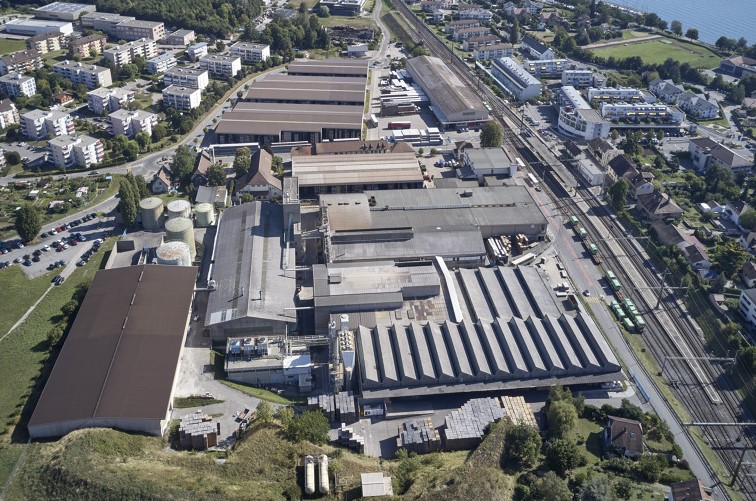The Vetropack Group is a listed and family-run glass packaging manufacturer in Switzerland. We at the VAP accompanied Vetropack during the negotiations on the new siding contract and the renewal of the sidings. We talk about this cooperation and the future of rail freight transport with Philippe Clerc, Head of the Vetropack site in St-Prex.
Mr Clerc, how did the collaboration between Vetropack and VAP come about?
Philippe Clerc: First we carried out an operational analysis to prove that Vetropack had been allocated too many tracks. VAP’s expertise and negotiating skills meant that we were able to make significant savings on the siding contract and renewal.
How important are the sidings for Vetropack?
The conditions of our market are becoming increasingly difficult. If we want to remain a leader here, we have to become more agile and faster. The VAP has helped us to improve the overall management of the railway infrastructure and the production processes. This helps us to increase our competitiveness and Switzerland’s security of supply. Vetropack’s strategy is based on the development of a green factory. Here we want to make the best possible use of sustainable energy in order to significantly reduce our CO2 emissions. Rail as a mode of transport is an essential part of this strategy. Our customers appreciate the fact that we are increasingly using rail. They approve of our method of transport in the area of glass recycling.
How did the VAP support you?
The VAP actively supported us in negotiating the siding dossier with SBB Infrastructure. Thanks to its excellent legal expertise, we were able to negotiate a good contract. This enables us to continue our environmental strategy by expanding rail transport.
How did you experience the cooperation with the VAP?
The VAP represents the interests of the owners of railway sidings. Thanks to its neutrality, it can effectively support its members. It has helped us to find an optimal solution so that we can continue to use our railway tracks.
Did you have any previous contact with the VAP?
We have been members of the VAP for several years and appreciate the work of the association.
What strengths do you see in the VAP?
The association is innovative in the development of new systems or infrastructures and adheres to the guidelines of the Federal Office of Transport FOT. It is committed on behalf of the owners of systems or wagons both to the expansion of the rail network and to the improvement of transport services by the freight railways. Thanks to the extensive legal expertise of the VAP, we were able to conclude an ideal follow-up agreement for our company and the continuation of our activities on the railways. As a result, we were able to optimise rail production at our site in St-Prex and minimise operating costs. I consider the VAP to be an excellent neutral negotiating partner.
What did you appreciate most during the cooperation?
The professional approach, the competences in the railway and legal field, the knowledge in the operational field as well as the relations with politics. All this contributed to a quick and optimal solution.
What else would you like to see from the VAP?
That it should be even more committed to the development of single wagonload traffic. The delivery windows, for example, are far too narrow. The capacities for freight transport on the rail network must be increased overall.
Who would you recommend to work with the VAP?
Any company that wants to build a rail facility in its operations centre. The VAP can be useful to all companies that have a railway infrastructure but do not have the necessary knowledge to negotiate and conclude contracts in this area.
Where do you see the most urgent need for action in rail transport?
As mentioned, we need an opening of the time windows for freight wagons. The number of goods trains must increase, for example through a clockface timetable. Rail freight transport should eventually come up to the level of passenger transport. In addition, we must ensure our connection to Europe. We must not be isolated from Europe.
What are the advantages of rail freight transport?
It is considered the safest mode of transport, which is why it is preferred throughout Europe. Rail is the best alternative to road, just look at the CO2 footprint. Large quantities can be transported by rail with just one train. And even at night or in the early morning.
What do you wish for the future of rail freight transport in Switzerland?
That the rail freight network can be maintained and expanded. Only in this way can we increase the environmental compatibility of freight transport. It would also be desirable to push ahead with innovations. This will enable us to remain competitive in the future, as innovations can reduce costs for operation, shunting, administrative tasks and other things. Overall, it is important to improve the operation of single wagons and thus the competitiveness of the rail network. We have to prepare rail freight for the future so that we are not overrun by trucks one day.
Good to know: The VAP advises and accompaniesVAP members benefit from our in-depth expertise in all areas of freight transport at national and international level as well as from our networking with business and politics. In the years 2020 to 2022, we supported our members with the following services:
|
